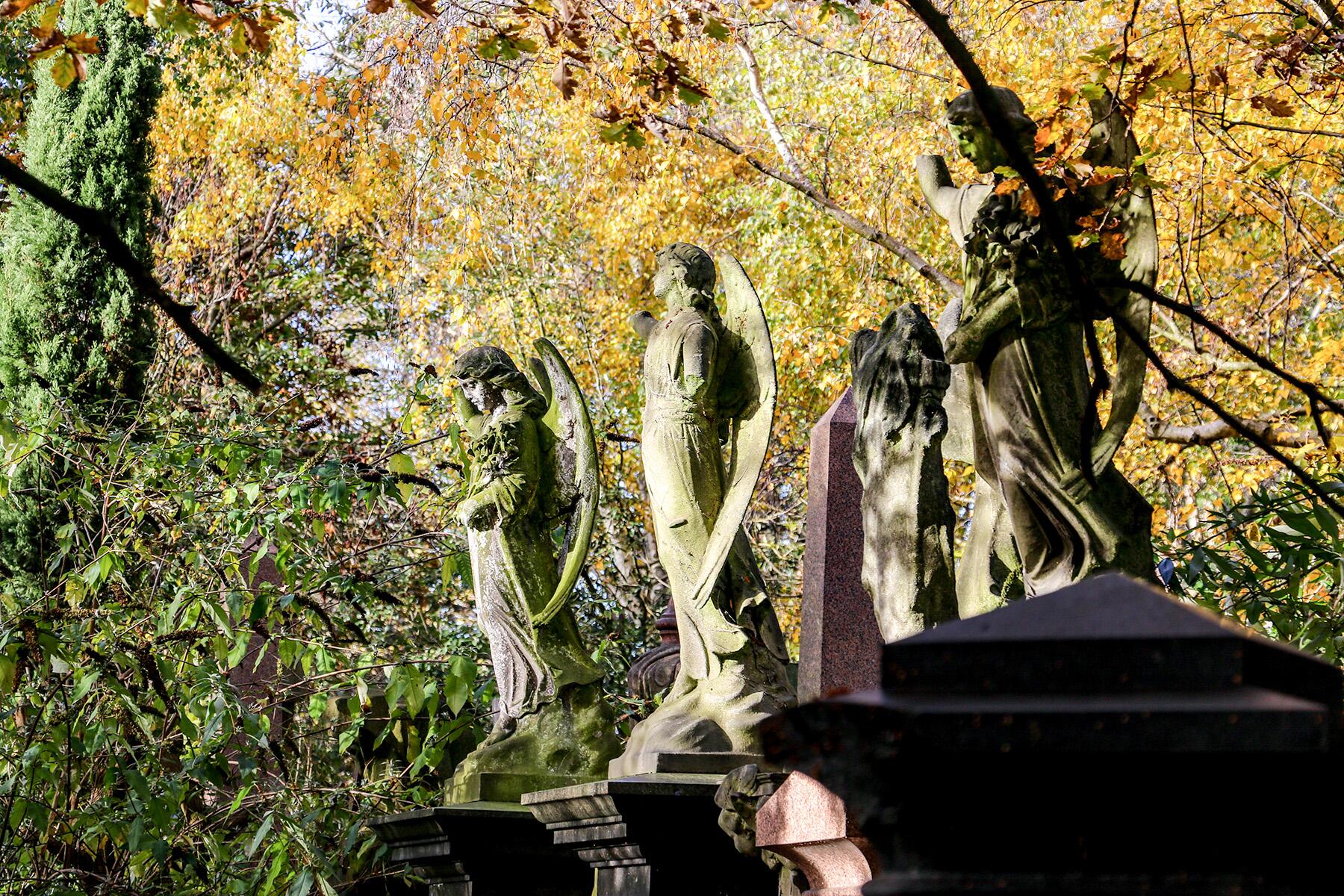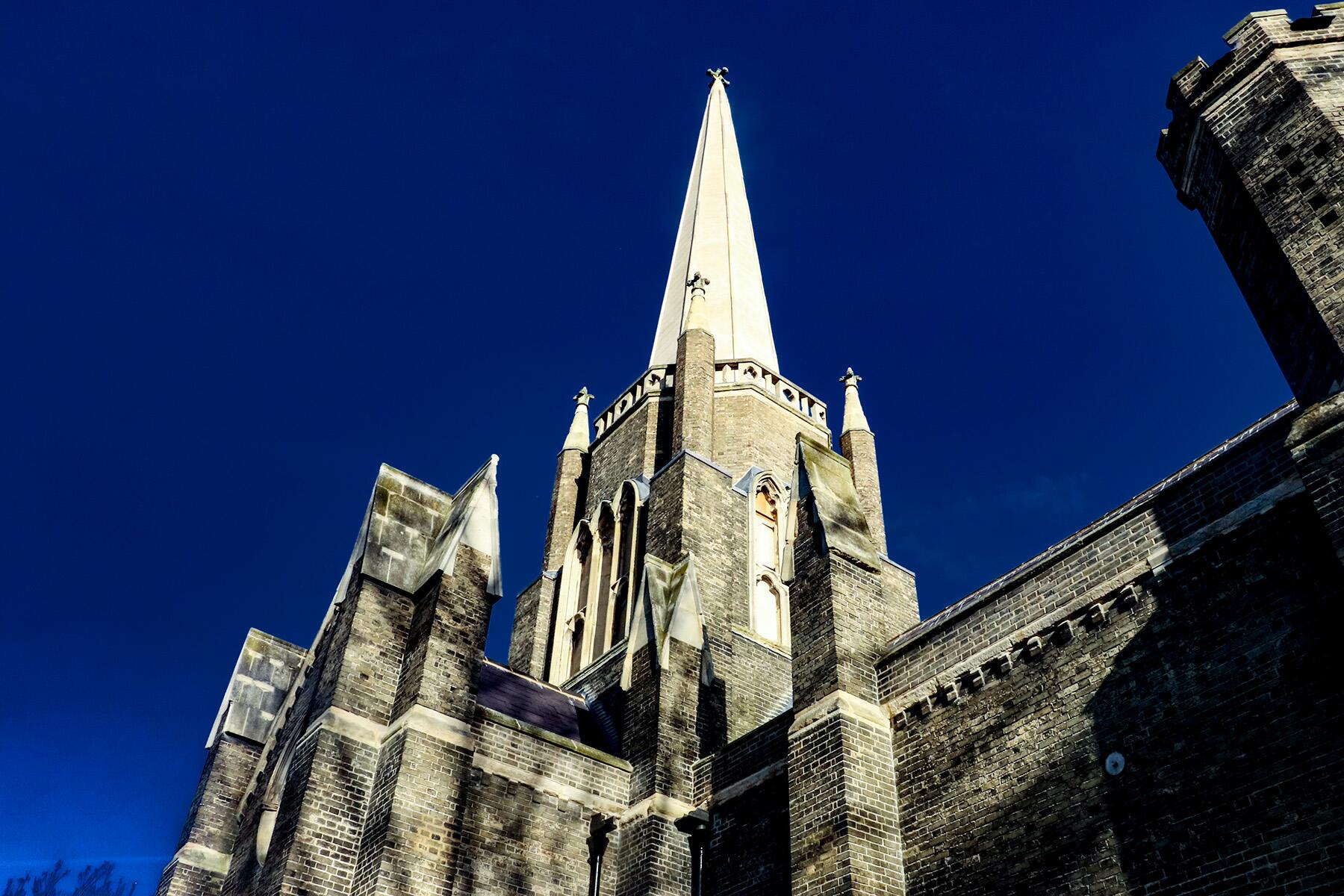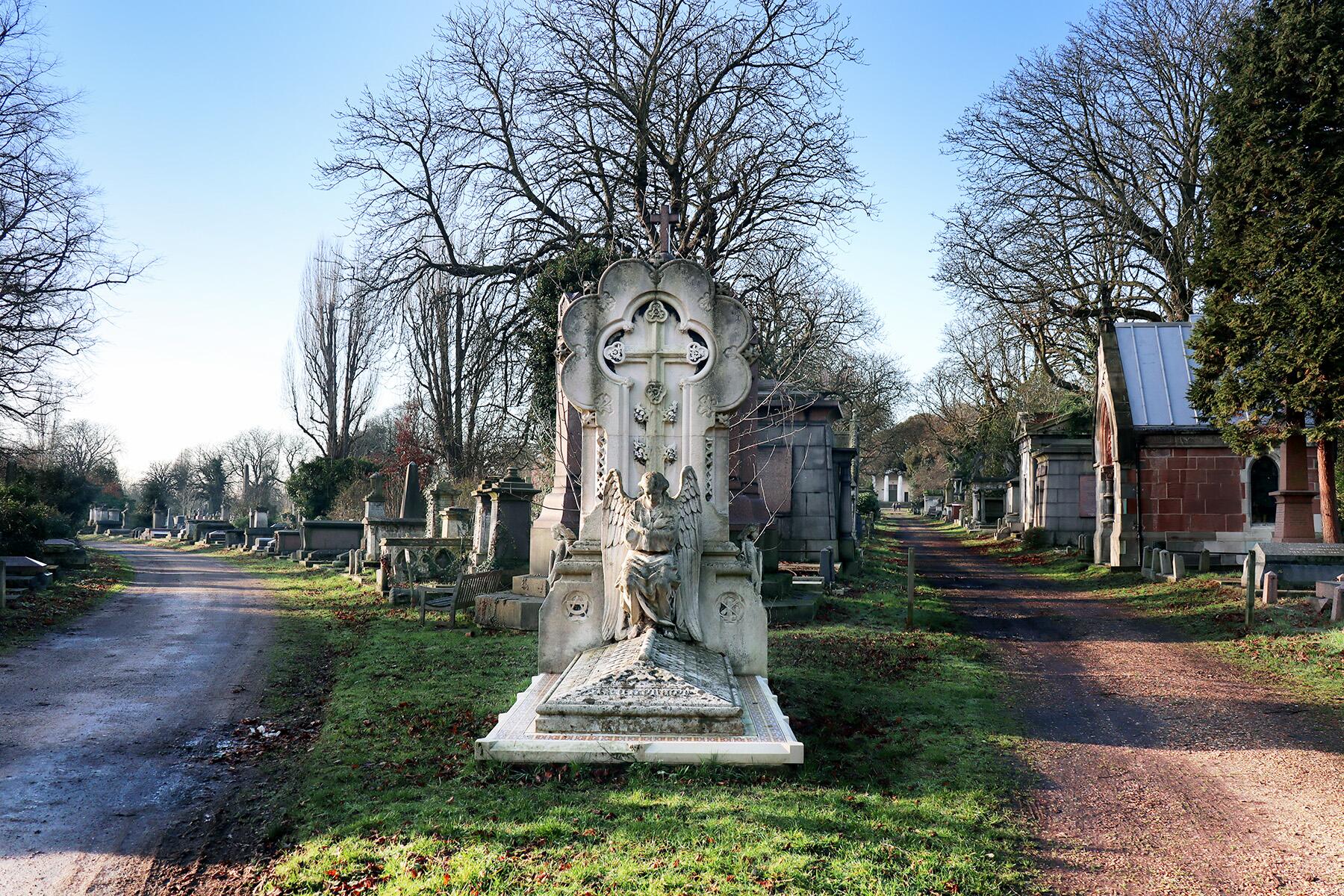A journey through London’s grand cemeteries where 1.6 million of the city’s dead reside.
Karl Marx stares loftily over me from a background of slender trees, a leaf resting on his shoulder. His oversized visage is one of many impressive monuments to be found in Highgate Cemetery, which he shares with the remains of 170,000 others. This is the most famous of London’s “Magnificent Seven” cemeteries, created across the U.K. capital between 1833-1841 to cope with overwhelmed smaller graveyards in the burgeoning metropolis.
By the time Kensal Green Cemetery—the oldest of the seven—opened, bodies were being crammed into church basements with the resultant stench blighting worshippers above. The description “oozing” was increasingly used. Something had to be done. Inspired by Paris’s Père Lachaise Cemetery, London’s garden cemetery movement was founded and, soon after, famous engineers, chess masters, and circus performers were being laid to rest in Kensal Green alongside the remains of everyday Londoners.
Seven Cemeteries
In a city of 9.6 million very much alive people, why would you want to spend time with over 1.6 million of its dead? And are the cemeteries really that magnificent?
Recommended Fodor’s Video
“’Magnificent’ isn’t a good word to describe them,” Highgate Cemetery’s chairman Dr. Ian Dungavell tells me as he guides me around the burial ground, and I agree with him. They’re each so diverse; some overgrown, some grand, some haunted (probably, but more on that later), all of them absolutely worth visiting.

Take Abney Park Cemetery, for example: Over the years, trees have grown between the gravestones, and winding paths make for a pleasantly serene walk amid the rush of the city. Tower Hamlets Cemetery has also let the greenery take over; now it’s a nature reserve in what is the most densely populated part of the country. Nunhead Cemetery also feels somewhat wild, and all seven cemeteries play an important part in London’s ecological battle. There’s even a rare spider to be found in Highgate’s ostentatious Egyptian vaults, where conditions are dark and dank enough to accommodate orb weavers.
The cemeteries’ eccentricity is matched by the architecture, with Abney Park’s Egyptian Revival columns, West Norwood Cemetery‘s iron monument to a wealthy foundry-man, and Nunhead Cemetery’s Anglican Chapel providing unusual yet highly photogenic scenes for your camera. Look a little closer and you’ll start to appreciate the diversity in the lives of Londoners gone by, not least in Kensal Green Cemetery where you’ll find gravestones adorned with flags of Caribbean nations and alphabets ranging from Ethiopian to Greek.
Stories of the Deceased
The cemeteries are alike in their varying states of (what some consider “romantic”) decay, something which distinguishes them from their pristine European counterparts. Sometimes you must look beyond the ivy and faded words to uncover the fascinating stories that are to be found in the lives of those long gone. Maybe I could borrow the Brompton tomb of Hannah Courtoy—which some believe is a time machine—and visit some of the Londoners who once experienced rich adventures.
One of the first I’d have a chat with is Elizabeth (Lizzie) Hawkins-Whitshed, interred at Brompton Cemetery. Her humble epitaph belies a life of adventure; Lizzie was the first to summit 20 mountains in Europe, posing in front of peaks in full Victorian skirts and doing her bit to advance the rights of women. Her grave is close to that of famous suffragette Emmeline Pankhurst. Tours are available at each of the cemeteries to help guide you to these fascinating people, with some offering information boards too.
I’d never heard of Tom Sayers, despite him once living less than a minute from my house (albeit 175 years ago), but in 1865, 10,000 people followed his funeral procession to Highgate Cemetery, at the front of which was his dog, a mastiff called Lion. Having been a popular pugilist, Sayers attracted the sort of crowd that didn’t care for the sensibilities of Highgate’s middle class. Much frivolity was reported, and that was just in the cemetery. Find Sayers’s grave today and you’ll see there, forlornly lying across it, a perfect depiction of Lion the dog.
In Highgate’s grand Circle of Lebanon, Dr. Dungavell points out how the tomb of an Italian restaurateur is almost opposite that of a duke, such is the egalitarian nature of this city of the dead. Douglas Adams and George Eliot’s graves are strewn with pens left there by visiting fans. George Michael’s headstone is surrounded by fresh flowers and artist Patrick Caulfield’s headstone simply says “Dead.” Jim Stanford Horn’s gravestone looks exactly like a Penguin book, with space left in the title for his partner. Horn isn’t famous, he just, in my opinion, has excellent taste and, like millions of others in London’s Magnificent (Miscellaneous? Spellbinding? Spiritual?) Seven, lies shoulder-to-shoulder with the great and the good beneath the trees.
From the Natural to the Supernatural
Yes, it’s time at last to talk about the ghosts and other creatures haunting the cemeteries.
“Where do ghosts like to haunt?” Dr. Dungavell rhetorically asks when I raise the subject of spooks. “The places where they died,” he answers, “and none of the people in Highgate Cemetery died here.” But what about the Highgate vampire?
In the 1970s, a “tall, dark man” was seen stalking the cemetery, animals were left among the gravestones drained of blood with “bitemarks” in their necks, and people predictably congregated with wooden stakes. Dr. Dungavell gives me a sardonic smile and laughs about the ensuing headlines and racy Hammer horror movie. The vampire was never seen again. Nevertheless, Highgate Cemetery is believed to be one of the most haunted places in London. Having been there after the sun’s gone down, I wouldn’t recommend getting locked in (the helpline posted behind the gates apparently isn’t answered after 5:30 p.m.), but the atmosphere isn’t in any way chilling. It feels serene, respectful, and just a touch dramatic.
Another Side of London
Although you probably won’t see a specter in these cemeteries you will, however, see a side of London that most tourists don’t. Tug at a thread of one of the deceased’s stories and you’ll soon unravel a captivating piece of history that you won’t find in any of the city’s museums, galleries, or streets. “LAWYER, should have been a marine biologist” reads Sally Hunter’s epitaph, which makes me realize that there’s something else we can learn from the seven multifaceted cemeteries: how to best live our lives and leave the world with an air of amusement, appreciation, and amelioration.
Apart from Highgate (entry: a very worthwhile £10/$12) the Magnificent Seven are free to visit. Brompton is the easiest to get to with West Brompton station steps away from the entrance. But please, leave the wooden stake at home.







I highly recommend finding a copy of, "Permanent Londoners", by Judi Culbertson and Tom Randall, which compiles brief biographies of the most famous of the interred across the city's Magnificent Seven and Westminster Abbey.